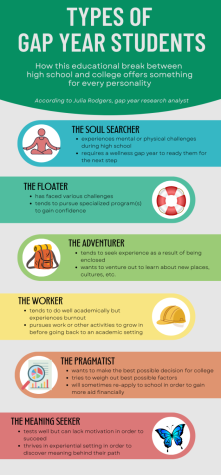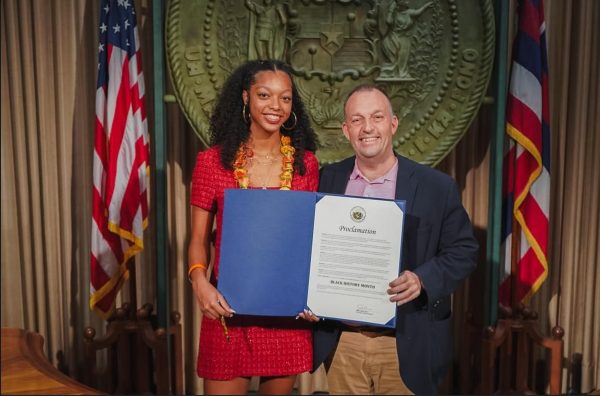Gap year gains popularity among high schoolers
While students spend much of their high school careers in anticipation of college, recent studies show that many opt to take gap years instead. It’s part of a rising national trend, in which taking an educational break between high school and college is an opportunity for students to gain real-world experiences.
For 2020 Sacred Hearts Academy graduate Adeline Busekrus, taking a gap year was one of the best decisions she has made.
“Stepping back and realizing you don’t have a plan, (and that) you’re entirely unsure, or maybe you just have no motivation right now to apply yourself in school is totally OK. It should be normalized,” she said. “A gap year, in my opinion and experience, helped me find direction and mature a lot, so I’ll be ready to return to school.”
According to the Gap Year Association (GYA), as many as 130,000 students took gap years during the 2020-2021 academic year, as compared to 40,000 to 60,000 before the pandemic. Taking time off may help students become more motivated to complete a degree when returning home, as stated in the Journal of Educational Psychology.
In a society that has either been industrially driven or college driven, stigmas surrounding gap years often prevent students from considering the option at all. Critics see gap years as an excuse to postpone schoolwork. NBC News stated that those who choose this path are less mature and academically rigorous.
As the first generation from her family to attend college, Academy senior Sydney Europa has always been on a steady path to higher education.
“I’ve never considered taking a gap year…because college is something that I’ve dreamed about for years,” she said. “I’ve seen so many of my older friends and family members go to these great universities, and I was like, ‘I want to do that, too.’”

Academy counselor Cleo Eubanks hoped to clarify the terms of a gap year.
“I am not sure if everyone understands the meaning of gap year,” she said. “Students still apply to college, get accepted, (but they) defer enrollment until the following year.”
Although the stretch of time for gap years is usually a semester to a year, some students wait longer to return to college years after. Eubanks says, “(A) gap year is one year. Anything beyond is just postponing a college education to work or do other things.”
What can come from gap years
Depending on the student, there are various activities that they may find themselves involved in like traveling, mission-work, apprenticeship and industry work.
“My student went to the (United Kingdom) to join a music ministry group and served the poorer neighborhoods in England,” said Eubanks, referring to a student from a previous school. “She loved it so much that she stayed the entire year.”
Growing research supports the idea that colleges encourage students to take gap years. Accordingly, former Academy counselor Randy Fong says, “Many colleges, in fact, encourage or endorse request(s) for gap years, including some of the top universities.”
Universities, like Princeton and Tufts, offer programs to support a more structured approach to gap years. Princeton’s program accepts 40 students and allows them to spend their first year in a different country, while Tufts encourages students to propose an independent plan.
With college tours and university representatives visiting the Kaimuki campus, the Academy encourages a college-bound mindset in its students. Eubanks says that a gap year is usually discussed “only to students who initiate the conversation.”
Reasons for gap years
From avoiding burnout to exploring beyond their hometowns, there are a variety of reasons why students choose the path of taking gap years.
“Not all students are ready to attend college right after high school,” Eubanks said. “Some students probably wanted to wait until college (or) universities were totally open before enrolling in college for the first time.”

Among the numerous reasons for taking time off after high school, Busekrus shared, “I’ve taken a gap year in hopes to decide if I want to be a teacher or not. I got a job to be an apprentice teacher to discern if I will get my bachelor’s (degree) in elementary education.”
Most studies showed that students reported not feeling ready as their reasoning behind taking a break after high school.
According to Europa, her experience at the Academy has prepared her for going away.
“The Academy’s offerings of early college classes, college visits and open conversations with teachers promotes a college-bound mindset,” she said.
Eubanks states that she, personally, would not take a gap year. She reasons, “Colleges have so much to offer students today, (such as) clubs, study abroad, career advising and assessments and many more enriching opportunities. The reason a student considers a gap year is to explore; one can do that while in college.”
Some benefits to gap years
Benefits of taking gap years stem from a range of financial, mental and physical levels, according to researchers.
Financially, students who take gap years could end up saving more in the long run due to an increased readiness to finish college.
Research consultant Julia Rodgers, who spoke at the Schools of the Future Conference in Hawaii, says, “The national average for graduating with a four-year degree is six years or sometimes more. The gap year average of gap year alums is closer to four years. So that’s money saving and a more streamlined college path for these students.”
Europa believes it would be different for her.
“I fear that I would lose my drive to pursue a higher education,” she said. “If I were to take a gap year, I would get so caught up in traveling that I probably wouldn’t return to school. I need to continue my momentum with being in (an academic setting).”
Eubanks adds to the importance of setting goals when taking a year off. Without a plan, “a gap year may not be beneficial,” she said.
Beside statistical data, the overall arc of students taking gap years is usually most beneficial for them mentally.
“You will learn more about yourself, you develop lifelong friendships and you develop independence,” Eubanks said.
While Busekrus says she may take longer to graduate because she did not have a clear career path, she agrees that the benefits were worth the risk.
“I persevered, bought my first car, met all kinds of people and am gradually realizing I really do want to be a teacher and finish up my schooling,” she said.
Having a plan
When considering whether or not to take a gap year, Eubanks stresses the importance of planning in advance.
“If these students’ end goal is to get a college degree, I would recommend having a plan,” she said.
Regardless of the decision to wait or attend college on the heels of high school, many would agree that both Europa and Busekrus serve as primary examples of students who are pursuing their own paths to success.

Emily is a first-year journalism student and a senior at the Academy. She hopes to be able to find connections within the Sacred Hearts community to the...


























